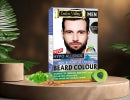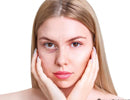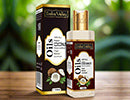It has been almost 115 years since paraphenylenediamine (PPD) was first used in 1907 for making chemical hair dyes. Since then a lot has changed. After a century of using harmful chemicals, hair colour users have, today, come a full circle. They have gone from adopting chemical hair dyes to slowly discarding it, and then going back to using plant based brown or black hair colours. In 2022, therefore, statistics indicate that hair colour users are preferring a combination of health plus looks, with health taking the front seat.
So, Which is the Best Hair Colour to Use in 2022?
The best hair colour to use in 2022 is, undoubtedly, the one with no or fewer chemicals added in it. And the best way to ensure that is by carefully going through each of their ingredients one by one.
That being said, we should also do a reality check. Dear readers, be always mindful of the fact that the word ‘natural’ is way overdone on packages of hair colours. In reality, hair colours cannot come “without any chemicals whatsoever”. Some chemicals always have to be added for enhancing their colouring effects, unless you are opting for pure henna or indigo leaf powder. But we all know that plants do not colour hair as vibrantly as chemicals do.
Their colouring effects come on slowly but somberly, somehow also making the user look quite elegant no doubt. To improve this condition, therefore, some responsible hair colour manufacturers have started adding some harmless organic compounds along with herbs. You can identify these harmless organic compounds by acquiring some basic background knowledge about them. You can go to the internet, as a first recourse, in this direction.
Did you also know that while herbal hair colour (henna and indigo) use just water for making the colouring paste, the chemical based ones use chemical developers? These developers have hydrogen peroxide (bleach) in them. The intensity and quantity of which is indicated with a number marked over their tubes. The higher is this number, the more bleach they have, bringing about more stunning and darker colouring effects. Let’s understand this better by finding out about how hair colours are categorised in the market today.
Modern Day Hair Colours Can be Categorised As;
- Temporary
- Semi Permanent
- Demi Permanent
- Permanent
Temporary hair colours are usually coloured chalks or sprays. They only coat the hair strands and wash away with a single wash. Temporary colours may cause some amount of dryness, scalp irritations and lots of dandruff.
The semi permanent hair colours can be either plant based or chemical based. The plant based semi-permanent hair colours, like henna and indigo, require hot water for making their colouring pastes. They also deposit their colour as coats over hair strands just like the temporary hair colours, only they wash away after 4 to 8 washes, depending upon the porosity and health of hair. These are the healthiest hair colours.
The chemical based semi permanent hair colour use developers (with numbers marked on their tubes) for making their colouring pastes. These work just like chemical based demi-permanent hair colours, only their colours wash away more quickly.
The demi permanent hair colours can be either mixes of herbs and nourishing organic compounds (organically natural), or they can be purely made up of chemicals. Demi-permanent hair colours use developers for making their colouring pastes. The organically natural demi-permanent hair colours come with plant based developers (no numbers marked on their tubes), while the chemical based demi-permanent hair colours come with chemical based developers (with numbers marked on their tubes).
The organically natural demi-permanent hair colours do not damage hair, while the purely chemical ones do. So, you must be very cautious while buying them.
Demi-permanent hair colours only slightly penetrate the hair shafts. So, they bring about more vibrant colouring effects, vis-a-vis the semi-permanent and temporary ones. Their colours usually wash away after 6 to 15 washes.
Permanent hair dyes are made up of pure chemicals. They always use chemical based developers (with numbers marked on their tubes) for making their colouring pastes. They deposit their colours deep inside the hair shafts, thereby completely changing the colour of hair. Their colours do not wash away and cause maximum damage to hair.
Which Treatment is Best for Hair Colouring?
The answer to this depends upon what exactly you are looking for as far as the end results are concerned. Do you want to completely change your hair colour? Then you must go for chemical based permanent hair dyes. But, if you want only sombre highlights and sober colouration, then plant based semi-permanent hair colours or organically natural demi-permanent hair colours are your things.
How Can I Cover Grey Hair?
If your concern is to nourish your hair and scalp more vis-a-vis covering your greys, then plant based semi-permanent hair colours are your best options. While the demi-permanent and permanent hair dyes offer more stunning and darker colouration, covering the greys better.
Pro Tip - Go for an organically natural demi-permanent hair colour that comes with a plant based developer (no numbers marked over them). It will come as totally devoid of hydrogen peroxide (bleach), ammonia and PPD.
Which Hair Colour Without Chemicals is Best?
Go for pure herb powders like henna or indigo if you want to avoid chemicals altogether. Herbal hair colours do not require developers, but only water for creating their colouring pastes. Such hair colours are the truly chemical-free ones.
Some demi-permanent hair colours, like Indus Valley New Damage-Free Gel Colour, are coming with plant based developers (no numbers). This is an innovation in the hair colour segment. Its developer has no hydrogen peroxide (bleach) in it. While its colouring powder has no ammonia and no PPD in it. So, it is not just safe, but it also leaves darker colouration vis-a-vis the pure herbs.
Pro Tip - Always do a patch test 48 hours before applying a demi-permanent hair colour. If you get rashes, redness or itching, avoid using it and go for a herbal semi-permanent hair colour instead.
Which Hair Colour Does Not Damage Hair?
Semi-permanent plant based hair colours like pure henna and indigo do not damage hair. They also suitably nourish and strengthen hair. The organically natural demi-permanent hair colours that come as enriching blends of herbs and organic compounds also cause minimal or no damage to hair. All chemical based temporary, semi-permanent, demi-permanent and permanent hair colours cause a range of damages to hair, so it is best to avoid them all..
Is An Organically Natural Hair Colour As Effective As a Chemical One?
Yes! A demi-permanent damage free hair color that comes as an enriched herbal formulation will not just colour your hair vibrantly but also help condition and hydrate it, turning it soft, bouncy and shiny. Users all over the world are switching over to such demi-permanent hair colours because;
- They just take 35 minutes to colour hair
- Their colour stays for up to 5 weeks
- They not just colour hair vibrantly, but also nourish the scalp with their enriched herb content.
Final Words
Feel free to experiment with your look with semi-permanent plant based and damage-free organically natural demi-permanent hair colours. Since they come as totally devoid of ammonia, hydrogen peroxide (bleach) and PPD, they are totally safe for hair and scalp. Do also keep coming back to this blog for the latest in healthy hair colouring. In case you have more to ask, feel free to chat up with our beauty and health experts with your comments below. They will guide you in selecting the right hair colour that would suit you the best not just looks-wise, but also health-wise. Till then, stay beautiful, naturally!








































































